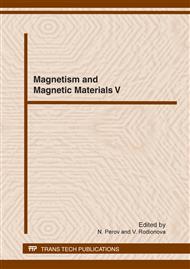[1]
J. Sakurai, Y. Yamaguchi, K. Mibu, T. Shinjo, Magnetic and transport studies on RPdSn (R = rare earth), J. Magn. Magn. Mater. 84 (1990) 157.
DOI: 10.1016/0304-8853(90)90177-r
Google Scholar
[2]
H. Kadowaki, T. Ekino, H. Iwasaki et al, Crossover from Magnetic to NonmagneticGround State in the Kondo Alloy System Ce(Ni1-xPdx)Sn, J. Phys. Soc. Jpn. 62 (1993) 4426.
Google Scholar
[3]
G.M. Kalvius, A. Kratzer, K.H. Münch et al, Magnetic behavior of CeTSn (T = Ni, Pt) from μSR and Mössbauer spectroscopy, Physica B 186-188 (1993) 412.
DOI: 10.1016/0921-4526(93)90589-x
Google Scholar
[4]
H. Kadowaki, M. Kohgi, K. Ohoyama, M. Kasaya, Neutron Diffraction Study of Antiferromagnetic Order in the Kondo Compound CePdSn, J. Phys. Soc. Jpn. 63 (1994) 2337.
DOI: 10.1143/jpsj.63.2337
Google Scholar
[5]
H. Kobayashi, F.E. Wagner, G.M. Kalvius, T. Takabatake, ll9Sn Mössbauer study of the CePtSn Kondo compound, Hyperfine Interact. 93 (1994) 1515.
DOI: 10.1007/bf02072902
Google Scholar
[6]
M.A. Polikarpov, V.M. Cherepanov, M.A. Chuev, S.S. Yakimov, 119Sn Mössbauer study of the 5f-electron behavior in U(In1−xSnx)3, J. Magn. Magn. Mater. 135 (1994) 361.
DOI: 10.1016/0304-8853(94)90368-9
Google Scholar
[7]
G.M. Kalvius, D.R. Noakes, A. Kratzer et al, Magnetic properties of the Kondo metals CePtSn and CePdSn from μSR, Physica B 206-207 (1995) 205.
DOI: 10.1016/0921-4526(94)00409-o
Google Scholar
[8]
H. Kadowaki, Spin-Slip Model of the Incommensurate Structure of the Kondo Antiferromagnets CePdSn and CePtSn, J. Phys. Chem. Sol. 60 (1999) 1199.
DOI: 10.1016/s0022-3697(99)00083-9
Google Scholar
[9]
D.R. Noakes, G.M. Kalvius, Spin-slip structure induced by the crystalline electric field in the incommensurate magnetic ordering of CePtSn, Physica B 289-290 (2000) 248.
DOI: 10.1016/s0921-4526(00)00385-9
Google Scholar
[10]
S. Dattagupta, Study of time-dependent hyperfine interactions by PAC, Mössbauer effect, μSR and NMR: A review of stochastic models, Hyperfine Interact. 11 (1981) 77.
DOI: 10.1007/bf01026470
Google Scholar
[11]
A.M. Afanas'ev, M.A. Chuev, Discrete forms of Mössbauer spectra, JETP 80 (1995) 560.
Google Scholar
[12]
D.G. Rancourt, Accurate site populations from Mössbauer spectroscopy, Nucl. Instr. Meth. Phys. Res. B 44 (1989) 199.
Google Scholar
[13]
M. Blume, J.A. Tjon, Mössbauer Spectra in a Fluctuating Environment, Phys. Rev. 165 (1968) 446.
DOI: 10.1103/physrev.165.446
Google Scholar
[14]
P.W. Anderson, A Mathematical Model for the Narrowing of Spectral Lines by Exchange or Motion, J. Phys. Soc. Jpn. 9 (1954) 316.
Google Scholar


